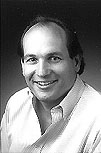|
CATALYTIC
REACTIONS
On
Volunteerism
For seven to eight
years now, I have thoroughly enjoyed the interactions with middle and
high school students at the Montgomery (County) Area Science Fair. I see
this as a chance to help promote the students’ interest in science
as well as being just plain fun and a chance to learn for me. I have also
been pleased with the response in 1999 and 2000 when I was able to get
the clinical fellows to pass around an e-mail announcement asking for
volunteers for judges at the fair (held in March or April each year).
What was disappointing
were the "rulings" from the Office
of Education that encouraging science fair participation does not
fall within its purview and from the Office
of Science Education that it could not send out an NIH-wide e-mail
invitation to judge in Montgomery County. While Dr. Fuchs [Bruce
Fuchs, director, Office of Science Education] did offer to set up
a website for judges similar to that for NIH speakers, he wanted information
about ALL the science fairs in the area, not just [those of] NIH’s
host, Montgomery County—and this does not seem to be a good solution
since the speaker website is so underutilized.
I would hope that
the NIH administration could revisit what its role should be vis-a-vis
local science fairs.
—Linda
Silversmith, CC
—We
do encourage people to support local science fairs, but we cannot show
favoritism to one school system over another. One possibility is to use
existing e-mail lists (such as the Fellows’ list) to do this, rather
than depend on a central distribution point.
—Michael
Gottesman
Deputy
Director for Intramural Research
I think that the
editorial on "Volunteerism
Among Scientists: Passing the Torch" [see The NIH Catalyst,
September–October 2000] should serve as a reminder to all intramural
scientists that they have an obligation to indeed "pass the torch"
in whichever way suits their interests and time. I for one enjoyed immensely
the time that I tutored students at a local "Saturday school."
Unfortunately, the program had to rent school space and was unable to
sustain itself for lack of funding. . . .
In reference to
volunteer work with professional scientific societies, I have found the
interpretation of ethics regulations at the NIH to be a significant hindrance
in these activities. More specifically, I was informed a couple of years
ago that if I served on a society’s finance committee (a volunteer
activity), EVERY activity with the society would be considered an "outside
activity." This meant that editorial duties (a volunteer activity,
and an important part of one’s scientific endeavors) could not be
performed using government facilities (phones, e-mail). This would have
made editorial work impossible.
I [support] removal
of such irrational constraints on volunteerism, certainly where there
is no remuneration or potential conflict of interest involved, and the
activity is supported by the volunteer’s supervisor.
—Raymond
Mejia, NIDDK
—NIH
employees are subject to the conflict of interest statutes and the Standards
of Ethical Conduct for Employees of the Executive Branch. The regulations
were written to provide a uniform legal framework in the federal workplace
that would ensure the public’s trust in the integrity of government
decision making. Certain ethics rules must be followed by all government
employees to prevent conflicts of interest—or even the appearance
of a conflict of interest—between an employee’s official duties
and his or her outside activities.
Under
the conflict of interest statutes, a conflict arises when an employee
has a personal or imputed financial relationship with an outside organization
and also deals with that organization as part of his or her official duties
(for example, through a contract, a CRADA, or an official duty activity).
Provided that an employee’s supervisor makes a determination that
a particular activity does not create a conflict, an employee is
encouraged to participate in activities with outside organizations. Such
participation may include membership in professional associations and
societies and/or service on boards and committees of nonfederal organizations.
An
employee may participate in activities of a nonfederal entity in one of
two ways: as an official duty activity or as an outside activity. Official
duties are extensions of regularly assigned duties, are performed during
regular working hours, and require advance review and approval by the
employee’s manager. Examples include serving as a federal liaison
to a professional organization, assisting other federal agencies, serving
as an officer of a professional society, and serving as a peer reviewer
of manuscripts for scientific journals. Conversely, consulting with industry
for compensation or maintaining a private professional practice must be
done as an outside activity. Taking financial responsibility for a professional
society is also considered an outside activity because you have a legal
obligation to act on behalf of the organization, which conflicts with
your obligation to the federal government. Prior to engaging in any activity
with an outside organization, an employee should consult with his or her
supervisor, ethics counselor, or the NIH
Ethics Office to ensure that the activity is legally appropriate and
does not present any conflicts of interest.
—Donna
Cencer, NIH Ethics Office
—Karen
Dalheim,Office of the General Counsel
|

![]()
